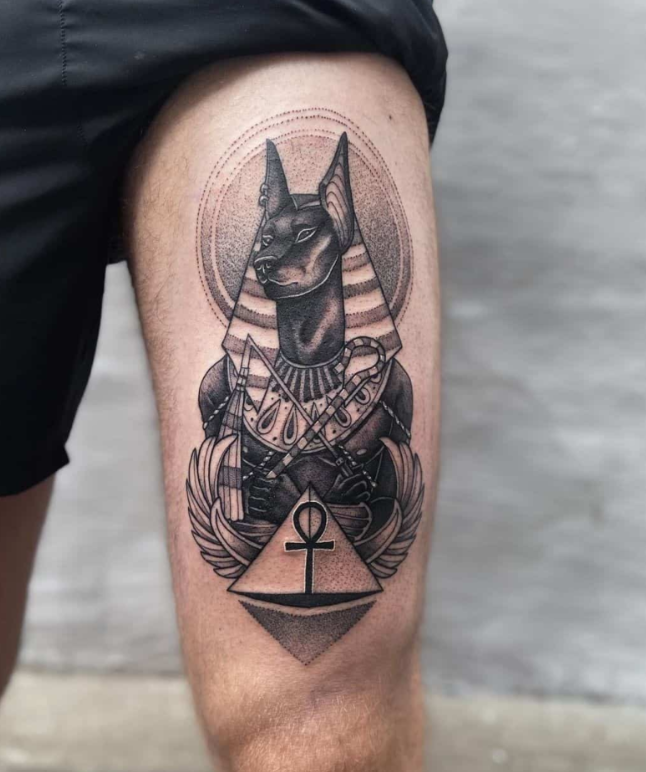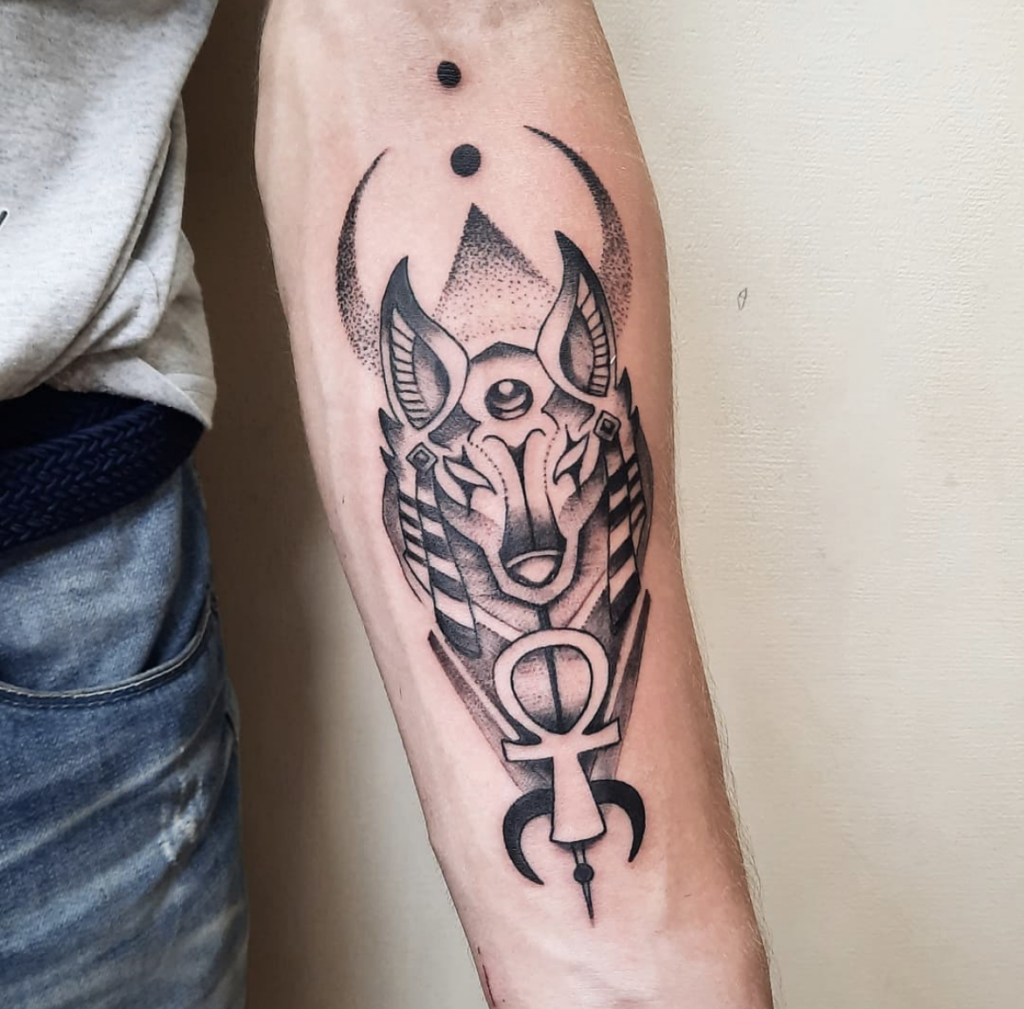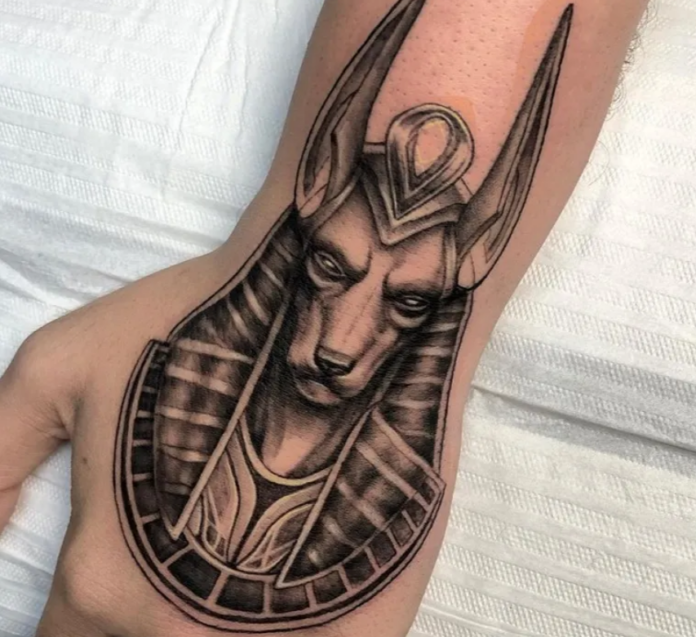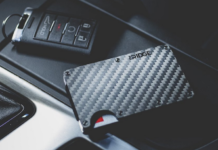Anubis tattoo – Getting a tattoo is a very individual process. Most people get tattoos in honor of a person or event that has a special meaning to them. A person who selects a culturally significant work of art does
so because they identify strongly with the message it conveys.
The Anubis emblem is very prominent in Egyptian religion and mythology. The significance of an Anubis tattoo is often something significant to the wearer. A tattoo artist giving a client a greyscale tattoo of the Egyptian god Anubis on his forearm. The significance of an anubis tattoo varies from person to person, and so does the meaning of an Anubis tattoo. Read on if you’re debating whether or not to get a tattoo depicting the Egyptian god Anubis. So that you may make a well-informed body art choice, we’ll go through the numerous interpretations of an anubis tattoo.
Anubis: Who Was He?
Ancient Egyptians held the god Anubis in high esteem. Anubis, who had the body of a man and the head of a jackal, was the protector of the afterlife. The Egyptians believed a well-balanced existence, including life and death, was necessary to enter the afterlife.
Anubis was the protector of the afterlife and the rituals surrounding death and burial, such as embalming and preserving the body. He guided people through the underworld and was responsible for determining whether or not their hearts were clean enough to pass the test and join the afterlife.
Tattoos of the Anubis Symbol
Fans of Egyptian mythology and the notion of “meat” (a balance between truth and honor in one’s life) that it embodies often mention the god Anubis. For many, Anubis stands for the kind of rich, just, and compassionate existence that sees one giving one’s all to the greater good of society. When depicting Anubis, including the flail and ankh symbols, which stand for the ma’at principles, is common.
Tattoos depicting Anubis may also stand for fortification. Some people prefer to have this tattoo on their back to show that Anubis is always looking out for them. Sometimes, Anubis is seen as “God,” keeping a watchful eye on the ink recipient.
Some people wear Anubis tattoos because they believe he protects the afterlife and the dead. This tattoo is meant to memorialize departed loved ones or express one’s spiritual views on the hereafter. Even people whose professions directly involve death, such as those in the funeral business, often sport Anubis tattoos.

The Many Faces of the Anubis Tattoo
An Anubis tattoo with the eye of Horus adds protective symbolism.
Anubis tattoos may be as basic as a single, bold image or as elaborate as a work of art. For added security, some people opt to couple Anubis with the eye of Horus (the sky deity and guardian of royalty), tattooing one on each shoulder.
To further emphasize Anubis’ position as keeper of the underworld and judge of those seeking entrance to the afterlife, he is frequently coupled with Osiris, the underworld
god.
Anubis might illustrate a narrative or sequence of events when paired with other Egyptian symbols. Symbols and hieroglyphs may be used to create stunning works of art.
The jackal’s head is a common symbol for Anubis in tattoos; it might appear snarling or with its lips closed. The human body itself varies in a wide variety of ways. The general shape of the head and shoulders is similar to that shown in the hieroglyphs, but considerably more detail has been added.
The significance of this Anubis tattoo needs little explanation.
However, the lower half of the body (below the breast) is often left up to individual taste. While some dress him Anubis in full battle attire, with weapons and a headpiece, others leave him essentially naked but for a covering around the hips.
Anubis Tattoos in a Variety of Designs
Many individuals who get an anubis tattoo choose a black and grey or greyscale design to appreciate the finer details better. This tattoo’s mix of black and grey is perfect for drawing attention to the shading that highlights critical characteristics. No matter how sophisticated the overall design is, black and grey seem to be the most popular among individuals with more traditional preferences.
Conventional and watercolor artists often choose color palettes based on ancient Egyptian art. Shadows persist, and they may become relatively dense at times.
If one is attempting to finish a sizable work like ancient Egyptian art, it is frequently advised to use traditional colors. Color preference is more of a matter of taste, with some opting for highly vivid hues.
Thoughts on Getting an Anubis Tattoo
When deciding on a tattoo, the design is as important as the tattoo itself. You can use a design inspired by ancient Egyptian art or hieroglyphs or choose a more contemporary option. Most choose black-and-white tattoos with just hieroglyphs and pictures of significant landmarks like the Sphynx and the Pyramids of Giza.
Even egyptian tattoos have been given a contemporary makeover. They modify the old artwork by including a more comprehensive range of facial expressions, weapons, and a more comprehensive range of attire and headgear. While most depictions of Anubis are very straightforward, other portrayals include added detail, like fangs or teeth, snarling lips, or fierce, focused eyes. Anubis’s eyes and lips are often rendered in exquisite detail, giving the artwork a sense of originality.
The first thing to decide is whether to use classic tattoo art or a more contemporary design. Once you’ve decided on a specific design for your anubis tattoo, it’s time to start looking for a tattoo artist whose aesthetic matches yours. Next, you’ll discuss the tattoo’s design and placement on your body.

Popular Anubis Tattoo Locations
Many individuals who get a tattoo of Anubis for its protective symbolism have it placed along their spine (assuming they have the full-length tattoo, which includes the head and standing body).
When the anubis tattoo is paired with the Eye of Horus, both tattoos are often put on opposite sides of the body, such as the shoulders, arms, or legs.
Here are some examples of anubis tattoo in various artistic techniques.
Plain Black-and-White Tribal Male Bust
A primary bust in a tribal design, suitable for both colored and black and white tattoos.
Beautiful Tribal Bust
An elaborate bust of Anubis in the black-and-white tribal art style is seen from the side.
Contemporary, Minimal, Monochrome Bust
This is a straightforward contemporary representation of the bust of Anubis; it might be rendered in black and white or colour.
A contemporary art bust of a scowling Anubis rendered in black and white.
This bust of Anubis has been updated to include a scowling expression and gaping maw in a more contemporary style.
Colorful, detailed, and modern bust
This colourful contemporary depiction of Anubis is very intricate and elaborate. The crossed sceptres may symbolize Anubis’s duty as the judge of the souls of the dead.
Anubis, the Warrior/Protector
Contemporary black and white artwork depicts Anubis’s upper torso in a combative or guardian stance.
Conclusions on Anubis Tatoos
The Egyptian god anubis symbol may signify various ideas to various individuals. Which of these tattoos a person chooses to get depends on which of Anubis’ many personalities they feel closest to.
For some, Anubis may represent afterlife spirituality because of his association with death and the underworld.
Combining imagery that represents his function as the judge of the hearts of people wishing to reach the afterlife with the concepts of ma’at (having a fair and balanced life) might be the meaning behind a tattoo of the anubis symbol.
Others see Anubis as a sign of supernatural defense, particularly when he is represented with a warrior’s outfit or the eye of Horus. After learning about the many interpretations of Anubis tattoos, you can now decide whether this ancient Egyptian god is a good fit for your body art. Ensure you put in the time and effort required to identify a qualified tattoo artist.

FAQs
What does an Anubis tattoo represent?
Tattoos depicting the Egyptian gods Anubis and Osiris, who symbolize death and rebirth, respectively, have recently gained popularity. Osiris was mercilessly killed by his brother Set in Egyptian mythology. Once Osiris’ corpse was put back together, Anubis took him to the underworld.
Is Anubis the deity of the graveyard?
The God of the dead in ancient Egypt, Anubis, was often depicted as a jackal or a human with the head of a jackal. The name Anpu is another name for Anubis.
Exactly what emblem represents Anubis’s guardianship?
Anubis, the ancient Egyptian deity of the dead, was shown as a black canine or a strong man with the head of a black jackal. He helped with mummification, guarded tombs, and determined who would be allowed everlasting life.

















